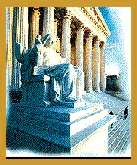CHAPTER 5 : THE JUDICIARY
5.0 Introduction
The Judiciary is that branch of government that interprets
law, settles disputes and imparts justice. In federal states, it also
acts as the guardian of the Constitution.
The Articles of Confederation did not make any provision
for a federal judiciary. However when the Constitutional Convention made
plans for a federal government, it found it necessary to provide for a
Judiciary. As Alexander Hamilton mentioned in No. XXII of íThe Federalistí
"A circumstance which crowns the defects of the
Confederation remains yet to be mentioned, -- the want of a judiciary
power. Laws are a dead letter without courts to expound and define
their true meaning and operation."
The Constitution specifically provided for a Supreme
Court, and also for "such inferior courts as the Congress may from
time to time ordain and establish." Though broad jurisdiction was
given to these courts, the Congress was left to decide how much jurisdiction
should be allocated to them.

Exhibit 5.1
The Supreme Court
In the United States of America there are two sets
of courts:
(1) The Supreme Court and the lower federal
courts and (2) the State Courts. The federal court usually
settles disputes between the center and the units, while the state courts
deal with subjects of state or local importance. Though these systems
appear separate they function in a parallel manner. For instance, it is
possible for the federal courts to receive appeals from the state courts.
Further, the Supreme Court holds the final jurisdiction in case of constitutional
matters.
[next page]
|